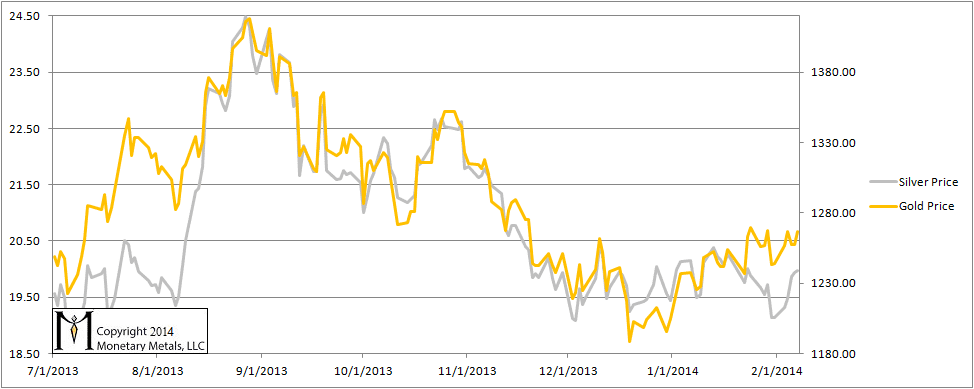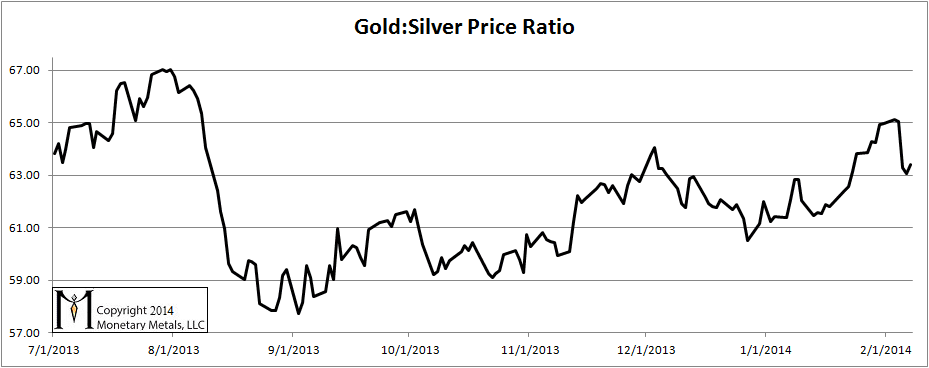Monetary Metals Supply and Demand Report: 9 Feb, 2014
The dollar dropped about another half a milligram this week, to 24.6mg (or, if you still believe the dollar is money, the price of gold rose $23). In silver terms, the dollar dropped 0.06g to 1.56g. Is this the big dollar breakdown (i.e. the big gold breakout)? Read on…
Here is the graph of the metals’ prices.
The Prices of Gold and Silver
We are interested in the changing equilibrium created when some market participants are accumulating hoards and others are dishoarding. Of course, what makes it exciting is that speculators can (temporarily) exaggerate or fight against the trend. The speculators are often acting on rumors, technical analysis, or partial data about flows into or out of one corner of the market. That kind of information can’t tell them whether the globe, on net, hoarding or dishoarding.
One could point out that gold does not, on net, go into or out of anything. Yes, that is true. But it can come out of hoards and into carry trades. That is what we study. The gold basis tells us about this dynamic.
Conventional techniques for analyzing supply and demand are inapplicable to gold and silver, because the monetary metals have such high inventories. In normal commodities, inventories divided by annual production can be measured in months. The world just does not keep much inventory in wheat or oil.
With gold and silver, stocks to flows is measured in decades. Every ounce of those massive stockpiles is potential supply. Everyone on the planet is potential demand. At the right price. Looking at incremental changes in mine output or electronic manufacturing is not helpful to predict the future prices of the metals. For an introduction and guide to our concepts and theory, click here.
Here is a graph of the gold price measured in silver, otherwise known as the gold to silver ratio. It corrected this week, to 63.4.
The Ratio of the Gold Price to the Silver Price
For each metal, we will look at a graph of the basis and cobasis overlaid with the price of the dollar in terms of the respective metal. It will make it easier to provide terse commentary. The dollar will be represented in green, the basis in blue and cobasis in red.
Here is the gold graph.
The Gold Basis and Cobasis and the Dollar Price
The April contract is still flirting with backwardation, ending the week at +0.025%.
It is notable that we continued with a pattern of a falling dollar and the cobasis is still firming. It’s early to make a confident prediction, but we would be inclined to expect further dollar weakness especially if as the dollar drops (i.e. the price of gold measured in dollars rises) the cobasis begins to rise. We shall see.
Now let’s look at silver.
The Silver Basis and Cobasis and the Dollar Price
In silver, the cobasis is not quite as firm as in gold. It fell a bit this week (-0.037%) whereas in gold it rose, and of course gold is backwardated and silver is not. Finally on this note, it is worth mentioning that we are comparing the April gold contract to the March silver contract. April is farther out towards the edge of the gravity well, whereas March should now be firmly in the tractor beams of temporary backwardation as of the 7 Feb.
We shall have to watch and see if there is a real turn in the silver cobasis upwards. Alternatively, the bearish interpretation is that the March silver contract has so far failed to muster a single day of backwardation so far. It’s getting late. Where’s the beef (if there is to be any)?
Last week we called out the fact that the basis fell more than the cobasis rose. This week, the basis fell further and the cobasis fell. We are once again witnessing widening spreads in the silver futures market.
© 2014 Monetary Metals





